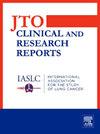LIBRETTO-431患者报告的结果:一线Selpercatinib与Pembrolizumab联合化疗治疗RET融合阳性NSCLC
IF 3.5
Q2 ONCOLOGY
引用次数: 0
摘要
对于晚期RET融合阳性NSCLC患者,一线selpercatinib与铂基化疗联合或不联合派姆单抗的获益已经有报道。来自LIBRETTO-431试验的患者报告结果(PROs)进一步支持一线selpercatinib在该患者群体中的益处。方法在意向治疗派姆单抗人群中,129例患者接受selpercatinib治疗,83例患者接受铂类化疗联合派姆单抗(对照组)。次要终点为NSCLC症状评估问卷(NSCLC- saq)总分的确认恶化时间(TTCD)。其他的PROs包括NSCLC-SAQ总分和个体症状评分的变化,欧洲癌症研究和治疗组织核心生活质量问卷健康相关生活质量、功能和症状、癌症治疗功能评估GP5项目(GP5)中患者报告的耐受性,以及pro版不良事件通用术语标准中长达1年的症状性不良事件的变化。TTCD被定义为从随机分组到达到预定阈值的评分首次恶化的时间,并在下一次评估中得到确认。患者报告的耐受性是指随着时间的推移出现副作用的患者比例。结果selpercatinib延迟了所有NSCLC-SAQ个体症状的TTCD。selpercatinib组与对照组相比,1年后NSCLC-SAQ总分也有临床意义的改善(平均差异= - 2.00,95%可信区间[CI]: - 2.94至- 1.05)。Selpercatinib延迟了欧洲癌症研究和治疗组织核心生活质量问卷测量的身体功能(风险比= 0.54,95% CI: 0.38-0.76)和作用(风险比= 0.59,95% CI: 0.37-0.93)的TTCD,与对照组相比,1年的身体功能显著改善(平均差异= 8.09,95% CI: 2.82-13.37;P = 0.003)。根据GP5测量,selpercatinib组报告了更好的耐受性,与对照组相比,副作用的比例更低(22.6%对39.7%,OR = 0.58, 95% CI: 0.33-0.99)。这些优点,结合selpercatinib已建立的疗效和安全性,进一步支持将一线selpercatinib作为标准治疗,并强调了在RET融合阳性NSCLC患者中进行早期和全面基因组检测的重要性。本文章由计算机程序翻译,如有差异,请以英文原文为准。
Patient-Reported Outcomes From LIBRETTO-431: First-Line Selpercatinib Versus Chemotherapy With Pembrolizumab in RET Fusion-Positive NSCLC
Introduction
The benefit of first-line selpercatinib versus platinum-based chemotherapy with or without pembrolizumab in patients with advanced RET fusion-positive NSCLC has been previously reported. The patient-reported outcomes (PROs) from the LIBRETTO-431 trial presented here further support the benefit of first-line selpercatinib in this patient population.
Methods
In the intention-to-treat pembrolizumab population, 129 patients received selpercatinib and 83 patients received platinum chemotherapy with pembrolizumab (control). Time to confirmed deterioration (TTCD) of the NSCLC Symptom Assessment Questionnaire (NSCLC-SAQ) total score was a secondary end point. Additional PROs included changes in the NSCLC-SAQ total and individual symptom scores, European Organization for Research and Treatment of Cancer Core Quality of Life Questionnaire health-related quality of life, functioning and symptoms, patient-reported tolerability by the Functional Assessment of Cancer Therapy GP5 item (GP5), and symptomatic adverse events by PROs version of the Common Terminology Criteria for Adverse Events up to 1 year were reported. TTCD was defined as the time from randomization to first deterioration in score that met prespecified thresholds, confirmed at next assessment. Patient-reported tolerability was reported as the proportion of patients with side effect bother over time.
Results
Selpercatinib delayed TTCD of all individual NSCLC-SAQ symptoms versus control. A clinically meaningful improvement in the NSCLC-SAQ total score (mean difference = −2.00, 95% confidence interval [CI]: −2.94 to −1.05) was also observed at 1 year for selpercatinib versus control. Selpercatinib delayed TTCD of physical (hazard ratio = 0.54, 95% CI: 0.38–0.76) and role (hazard ratio = 0.59, 95% CI: 0.37–0.93) functioning measured by European Organization for Research and Treatment of Cancer Core Quality of Life Questionnaire, with significantly improved physical functioning at 1 year versus control (mean difference = 8.09, 95% CI: 2.82–13.37; p = 0.003). The selpercatinib group reported better tolerability, as measured by GP5, with a lower proportion bothered by side effects compared with control (22.6% versus 39.7%, OR = 0.58, 95% CI: 0.33–0.99).
Conclusions
These PROs, combined with the established efficacy and safety profile of selpercatinib, further support the use of first-line selpercatinib as a standard of care and highlight the importance of early and comprehensive genomic testing in patients with RET fusion-positive NSCLC.
求助全文
通过发布文献求助,成功后即可免费获取论文全文。
去求助
来源期刊

JTO Clinical and Research Reports
Medicine-Oncology
CiteScore
4.20
自引率
0.00%
发文量
145
审稿时长
19 weeks
 求助内容:
求助内容: 应助结果提醒方式:
应助结果提醒方式:


